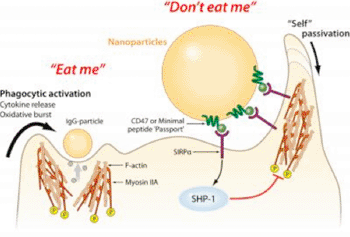Coating of "Self” Peptides Protects Nanoparticles from Macrophage Destruction
By LabMedica International staff writers
Posted on 05 Mar 2013
Nanoparticles coated with peptides derived from the human protein CD47 were protected from uptake and destruction by macrophages in a genetically engineered mouse model system.Posted on 05 Mar 2013
The membrane protein CD47 is reportedly a "marker of self" in mice that impedes phagocytosis of “self” molecules by signaling through the phagocyte receptor CD172a. CD47, which is found on almost all mammalian cell membranes, binds to the SIRPa macrophage receptor in humans.

Image: Diagram of Macrophage Interaction: Macrophages are immune cell “border guards” that have evolved to eat all sorts of foreign microbes, but they also eat many particles that are intended for therapeutics and imaging. A “Minimal peptide ‘Passport’” attached to the particles provides recognition signals so that the particles are not eaten, thus improving delivery to diseased cells in the body (Photo courtesy of Mary Leonard, Biomedical Art & Design, University of Pennsylvania).
Investigators at the University of Pennsylvania (Philadelphia, USA) used computers to design the smallest peptides from human CD47 (hCD47) that could perform the same function. They then synthesized these peptides and attached them to virus-size particles for intravenous injection into mice that had been genetically engineered to express a CD172a variant compatible with hCD47.
Results published in the February 22, 2013, issue of the journal Science revealed that the coating of “self” peptides delayed macrophage-mediated clearance of the nanoparticles, which promoted persistent circulation that enhanced dye and drug delivery to tumors.
"There may be other molecules that help quell the macrophage response," said senior author Dr. Dennis Discher, professor of chemical and biomolecular engineering at the University of Pennsylvania, "but human CD47 is clearly one that says, "Do not eat me. It can be made cleanly in a machine and easily modified during synthesis in order to attach to all sorts of implanted and injected things, with the goal of fooling the body into accepting these things as self."
Related Links:
University of Pennsylvania














